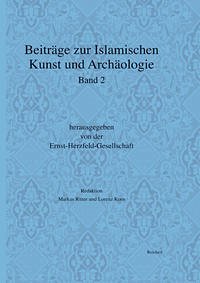Volume 2 of the „Beiträge zur Islamischen Kunst und Archäologie“ (BIKA, Contributions to Islamic Art History and Archaeology), published by the Ernst Herzfeld Society, presents contributions from the European colloquies in Vienna in 2007 and in Bamberg in 2008, which were organised on behalf of the Society. Subjects include architecture and archaeology as well as painting, textile arts, minor and applied arts. They cover the lands from Spain to Iran and India, and back to Europe; in chronology, they range from the Early Islamic period to the 20th century. Following the title of the Vienna colloquy, aspects of representation are a red herring in several contributions; in others, trade and reception in or from Europe. Each contributions starts with an English abstract. 160 figures, partly in color and most of them published for the first time, turn the volume into a sumptuously illustrated book. The editors are Markus Ritter (University of Zurich) and Lorenz Korn (University of Bamberg). The contributions cover three greater regions and periods, starting with research on the 8th-13th centuries in Islamic Spain. Antonio Pena (Barcelona) places the re-use of ancient „spolia“ in the context of caliphal representation [Spolia Serving Power: The Testimony of the Great Mosque of Córdoba]. Magdalena Valor (Sevilla) sketches the urban building history of the Almohad centre [Sevilla, Capital of the Almohads in al-Andalus]. Tobias Rütenik (Berlin) demonstrates how to deduce re-used Islamic sacred buildings from Christian ones [Transformations of Mosques to Churches at Toledo From the Perspective of Building Archaeology]. Klaus Graf (Saarbrücken) presents a typology of pottery from archaeological finds [The Islamic Pottery of Cuncos, Estremadura]. Iran and Central Asia in the 12th to 15th centuries form a second focus. Lorenz Korn (Bamberg) introduces a scarcely-known domed mosque datable to the post-Seljuq period in Eastern Iran [The Masjid-i Gunbad at Sangan-i Pa’in (Khurasan/Iran): Architecture, Decoration, and Inscriptions]. Markus Ritter (Zurich) discusses, based on new reasearch, a unique textile with Arab inscriptions [Art With a Message: The cloth of Silk and Gold for the Ilkhan Abu Sa’id of Iran (Burial Garment of Rudolph IV in Vienna) - Reconstruction, Type, Medium of Representation]. Márta Járó (Budapest) examines a technical aspect in the cloth [Late Medieval Technology of Craft: The Metal Thread in the Vienna Cloth for Abu Sa’id]. Yuka Kadoi (Chicago) poses for the Timurid period the question of flags in pre-modern Islamic states (On the Timurid Flag). Art for Europe and Islamic art in Europe constitute the third part, covering the 15th to 20th centuries. Barbara Karl (Vienna) looks into luxury objects from India as products for trade (Art for the International Market: Three Mother-of-Pearl Objects from Sixteenth-Century Gujarat in Early Modern European Collections). Iván Szántó (Budapest) raises attention to Eastern European parallels of Europeanizing Safavid painting in Iran (Monumental Art East of the Baroque) and to the reception of Arab forms in Hungary (Mamluk Influences in Hungarian Art). Martin Gussone (Berlin) analyzes and interprets the eclecticism of a German mosque from 1915 [The Mosque in the Half-Moon-Camp at Wünsdorf Between Jihad Propganda and Orientalism].

